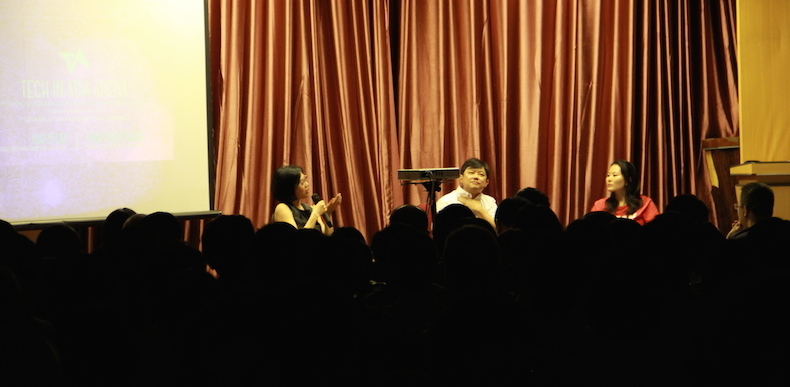
When we heard that Monk’s Hill Ventures and Digital Media Partners were visiting Ho Chi Minh city, we jumped on the opportunity to put them both on a panel at a Tech in Asia meetup event, as well as to judge our inaugural startup pitching competition in Vietnam: Tech in Asia Arena HCMC.
Triip.me won the pitch contest and got the title of “most promising startup”. It was a difficult choice as the six finalists came from a variety of industries.
In addition to the pitches, we held a one-hour long fireside chat with Kuo-Yi Lim, managing director of Monk’s Hill Ventures, and Khor Chieh Suang, principal at Digital Media Partners where we spoke about globalization and tackling Southeast Asia for your business.
Speaking to the 270-strong crowd of local entrepreneurs, developers, and investors, Lim talked about the three ways a company in Southeast Asia region can go global: solving a global problem, solving a Southeast Asian infrastructural issue, or targeting a specific segment of the market that is quite common across Southeast Asia.
Finding your single market in Southeast Asia
According to Lim and Suang, one common mistake entrepreneurs in Southeast Asia will make is looking at the region as a single market. The second mistake is thinking that Vietnam’s population of 92 million or Indonesia’s population of 250 million people is one single market. The reality is that each population itself is stratified. Khor recommends slicing markets by spending power as the different groups of people with different spending power will behave differently. For example, the 50 million wealthiest people in Indonesia will probably have more in common and behave similarly to the wealthiest people in Ho Chi Minh city, or Manila, or Klang Valley, rather than 100 million almost-as-wealthy Indonesians.
Lim gave the example of Reebonz, a company which sells luxury bags to wealthy consumers. For Reebonz, their addressable market size is about 60 million people across Southeast Asia. These 60 million customers spend an average of US$3,000 a month on luxury bags, and reside in Singapore, Kuala Lumpur, Jakarta, Bangkok, Hong Kong, Manila, Australia. As of a year and half ago, the company was valued at US$250 million.
What is that one keyword you want to own?
Lim said that since enterprises can now buy their software much like consumers do, for B2B products, there is no longer a need for a drawn-out sales process – enterprises can now buy software through a website. As a result, value propositions for all businesses need to be as concise and directed as keyword search terms. Lim asked the audience,”What is that one keyword you want to own on Google? When you type in those one or two keywords in Google, you want your company’s name to come up first. Or, put in another way, when you type in the problem you want to solve, does your name come up first?”
If you cannot identify your value proposition, then it’s difficult to strategize your SEO, and that minimizes your chances of discovery through search. The key is to be able to articulate your value proposition in one or two words.
Big companies can be built in Southeast Asia, for Southeast Asia
In addition to Reebonz, Lim and Suang mentioned Garena as companies that have successfully addressed global needs from a base in Southeast Asia. The key for companies is to have a playbook for market expansion. Lim talked about the need to articulate three things you need to do in each new market to be successful. In this playbook, also dedicate two or three chapters to local conditions. Ultimately, data is important, so it’s good to go on the ground in order to understand the market.
One audience member asked if it’s possible to build a “big” company from Southeast Asia. Lim said that there’s no reason to set one’s sights too small.
“It is possible to build reasonably big companies in SEA. And I’m hopeful, and there’s a reason why we started the fund. When we started the fund, it’s a 10-year commitment. When I start this fund today, I asked my investors, ‘Give me money please. Give me 80 million dollars. And i’m going to run this organization for the next 10 years to make money for you.‘ I’m in my 40s, I’m going to put in the next 10 years of my life to do this. So I better be pretty bullish about the market I’m going into. We are bullish that in the next years, there will be 5-10 startups in Southeast Asia that will can hit US$250-500 million in valuation.”
Finding your single market in Southeast Asia
No comments:
Post a Comment